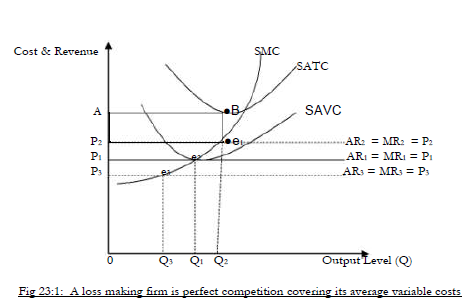A perfectly competitive market is the one where prices of commodities are set by the forces of demand
and supply. All the firms in the industry are price takers and the goods produced are homogeneous. In
this market structure, firms incur average fixed cost and average variable costs. A firm may continue
production of goods even though it can sell at a loss if it can cover its average variable costs. By
producing more, it will minimize its losses.

Assume that the price was to fall from P2 to P1 the firm will be at equilibrium at the point where MC = MR.
At this point, it is producing an output of OQ1 . This output will be earning revenue represented by the area
OQ1 e2 P1 but at this point it is still making losses because the average total cost is higher. Though incurring
losses, the firm is at the point where it is just covering its average variable cost. This point is called the
shutdown point because below this price (OP1 ) it would benefit the firm to quit production. However, at this
point the firm could decide to either close down or continue production because it just covers it coverage
variable costs.
Below this price (OP1 ), say at price OP3 , the firm will be at equilibrium at point e3 producing an output of
OQ3. At this point, the firm its not covering its average variable cost and continuing production will see the
firm increasing its losses. So at the point where the firm is not covering its average variable costs it would
benefit the firm to quit production. Therefore at some point, though a firm produces while selling at a loss it
can not indefinitely continue doing so. This is because when it is not covering its average variable cost (AVC)
losses are reduced by ceasing production.
Wilfykil answered the question on
February 6, 2019 at 09:07